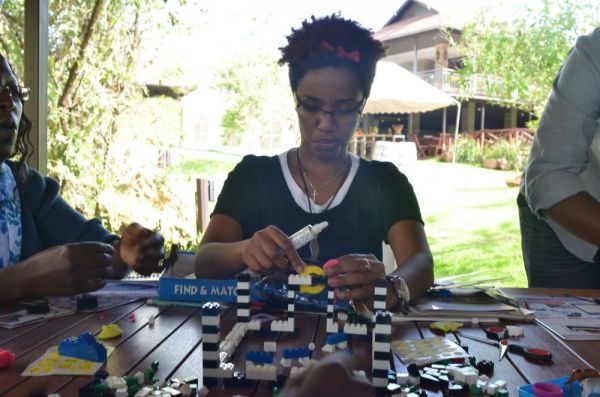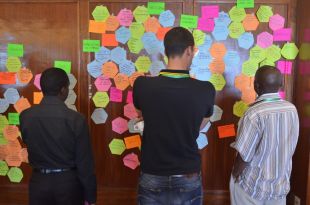Could a ‘Slum Technology Hub’ Lead the Way To Nairobi’s Future?

A workshop participant designs Ubuni Studio. Photo credit: Jason Patinkin
Following on the heels of the Futures Workshops, the Informal City Dialogues’ Innovation Workshops are unfolding in our six partner cities. Click here to read about the Innovation process.
If you had $100,000, how would you work toward creating a better city?
That was the question asked and answered at Nairobi’s innovation workshop, held over two days in April with a cast of thirty stakeholders who regularly interact with the informal sector. The group, many of whom work in Nairobi’s informal settlements, included activists and NGO workers, futurists and technologists, media and entrepreneurs, planners and policy wonks. At the Great Rift Valley Lodge overlooking the popular tourist retreat Lake Naivasha, between tea breaks and garden walks, the team discussed not only what an ideal city would look like, but how to push Nairobi in that direction. This ideal city was dubbed Najivunia at the scenario planning workshop held a few weeks earlier, and now it was time to talk about making that scenario a reality. By the end, the group presented four projects aimed at making Nairobi more like Najivunia, and voted for one to be considered for a $100,000 Rockefeller Foundation grant.
Najivunia (pronounced nah-jee-VOON-ee-uh) is what Nairobi could be in 2040. Najivunia is efficient and high-tech, with a government that responds to its citizens’ needs. In a skit, the workshop participants showed Najivunia as a place where the governor and a garbage collector can ride a bus together to work, chatting casually about education because they send their children to the same public school. They mimed high-tech swipe cards for payment on the bus, an upgrade from Nairobi’s notorious matatu public minibuses. Then the mayor and waste collector bought drinks at the same cafe — a roadside stand turned officially licensed shop that used government-subsidized solar power.

Participants voted on which of the four innovations should compete for a grant from The Rockefeller Foundation. Photo credit: Jason Patinkin
Surely Najivunia is ambitious, considering that today’s Nairobi looks more like Vulture City, where the government rarely provides adequate services, inequality is severe and crime is rampant. But the skit’s performers qualified that Najivunia is not trying to outdo itself. “Inequality is still there,” said one actor – the governor ordered an elaborate cappuccino while the garbage collector bought a simple tea — “but there’s respect and understanding.” Likewise, the informal sector in Najivunia is not abolished, but enhanced. Rather than scuttling the matatu fleets in favor of shiny new light rail, they’re upgraded to incorporate more efficient buses. The government is responsive, but citizens play their role too – the café, for example, once a makeshift business, must pay for a license in order to receive energy subsidies. Technology is at the heart of Najivunia’s efficiency, not because it’s flashy, but because Nairobi today is considered by many to be Africa’s technology hub.
So how do we get from here to Najivunia? Most of the conference was spent brainstorming, sticking hundreds of colorful ideas onto one wall about the challenges Nairobi faces and the ways to overcome them. Then, after successive rounds of debate and voting, the group chose four final projects to help achieve Najivunia, and split up to develop these ideas and present them for a final group vote. The winner will be submitted to the Rockefeller Foundation for consideration for the $100,000 grant.
The first project presented was the Informal City Lab, a sort of think tank focused on building policy that addresses the real needs of people in informal settlements. “The biggest problem we are addressing is there seems to be several solutions out there with no problem,” said one member of that group. “We exist to ensure that the right problem is being addressed, and the best solution is found for this problem.” To do so, the Informal City Lab would have people in slums identify their own problems, and connect them with the relevant policy makers. Then, the lab would test proposed policies to measure their effect on slums. In this way, government would better respond to real problems, rather than implementing untested solutions for problems that may not be critical.

Taking a look at the Urban Eco-Spaces map. Photo credit: Jason Patinkin
The next group focused not on broad policy frameworks but on solving a problem in a narrow area: Waste collection in Babadogo slum. Still, their idea had wider implications for the role of informality in the city. Currently in Babadogo, youth have organized themselves to collect waste in small teams. They dump the garbage by the street in large piles for pick-up, which may or may not occur. The system is far from ideal — waste is not sorted, it sits out in the open and is not properly linked with the actual municipal pick-ups. The collectors receive little pay and are poorly supplied. But the simple outline of a working system is there, and with current resources, it nominally succeeds, said one Babadogo resident at the workshop. The trick is to upgrade it. “The basic economic model exists and it works,” he said. “You just have to organize it. The youths don’t use proper equipment, so we want use the money to buy waste-collection equipment. We will strengthen the existing system.” The youth waste-collection programs could be streamlined, better equipped and connected to the municipal system that now only ventures to the outskirts of slums. The Babadogo waste-collection project shows that properly supported informal solutions can provide services while coexisting with formal systems.
Third was Ubuni Studio, which took the reliance on informal solutions even further. Ubuni Studio’s group presented a showy Lego model of a slum technology hub, complete with 3D printing, welding and woodworking equipment. The studio would be open to the public, allowing people to learn crafts and build their own solutions to local problems using the latest technology. Ubuni Studio bypasses the formal sector, placing trust in local people’s ability to find working solutions when given the right resources. “People often say, ‘Oh, people in informal settlements really need X,’ but that might not be so,” said one group member. “So here, the people in slums can make what they want and sell it at low cost. We provide a space for innovation and creativity.”
The final group offered an “Urban Eco-Spaces” project to reclaim land along streams in slums in order to better supply drinking water and sanitation services while creating open space for communities. This group presented an elaborate map showing how a community benefits when their local ecology is preserved and they are given ownership of communal space. But the Urban Eco-Spaces received the most criticism because of the contentious issue of land ownership and the impenetrable layers of bureaucracy in Nairobi’s current state. “If you get the government approval then the people won’t support it,” said one city planner, cognizant of the mistrust that exists between informal and formal sectors. “You’ll have to get the local cartels on board and that has all these problems,” said another who had experience dealing with illicit slum power structures. But the Urban Eco-Spaces group stood firm. “Those are exactly the types of problems we face when doing projects like this,” said an NGO worker who specializes in implementing water treatment systems in slums, “but if you can bring everyone together it can really work.”
After a close vote, Ubuni Studio won the chance for consideration of the grant, perhaps reflecting Nairobi’s love of technology. But taken together, the four ideas illustrate Najivunia, what Nairobi could someday be: A place where government provides adequate solutions to pressing problems; where the informal is appreciated, strengthened, and linked to the formal; where local innovation creates modern fixes to slum issues; and where the opinions of all stakeholders are taken into account.
After a round of applause for the four projects, the participants headed to the bar for some well-deserved drinks as the sun set over the Rift Valley. The next morning, they boarded the bus to Nairobi, leaving the resort’s structure and luxury behind, but bringing visions of Najivinuia back to Vulture City.









